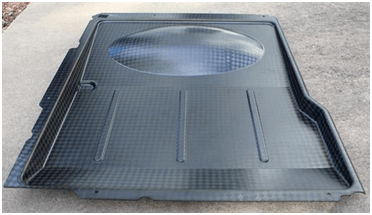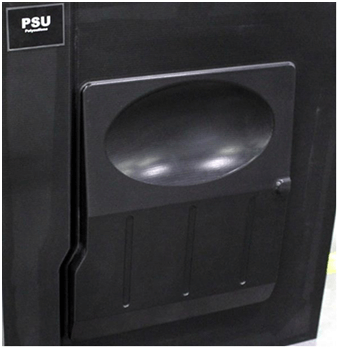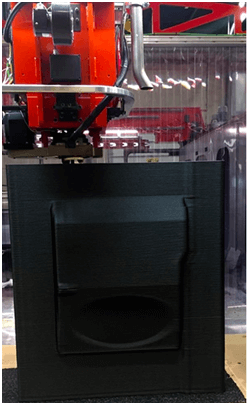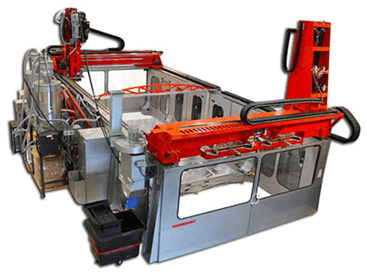Injection molding process of PSU composite plastic mold for 3D printing of large helicopter parts

For large parts such as helicopter structures, several tons to dozens of tons of molds are usually needed to complete the injection work.Such a mold through the traditional processing technology is not only expensive, the processing process is also full of challenges.It is not only required that the machine table can bear large weight, the equipment must have the characteristics of large load-bearing and high rigidity, but also must have a large enough table size and working stroke to adapt to it.Because the strength and hardness of the die are very high, coupled with the often use of small diameter end milling cutter with large elongation to process the die cavity, so the processing process is prone to chatter.
3D printing technology has brought a new entry point for large-scale mold manufacturing.Take PSU plastic for example, this plastic vapor resistance, hydrolysis resistance, non-toxic, high temperature steam disinfection resistance, high transparency, good dimensional stability of plastic materials.This is to process PSU plastic mold through 3D printing technology, and then finish the final product processing through injection molding.It is a fast, good and economical shortcut for small batch production of large parts.
Recently, Purdue University’s Composite Manufacturing and Simulation Center, Thermwood, Applied Composites Engineering (ACE) and Techmer PM’s joint team implemented the 3D printing of PSU composite molds for injection molding of helicopter parts.
This may be the first successful application of carbon fiber reinforced PSU plastics to a 3D printing process.Using Thermwood’s LSAM-Large Additive Manufacturing system, the helicopter molds were 3D printed and machinedonce.
3D printed injection moulds
Each member of the team plays a key role in the production of helicopter components: Techmer PM, a manufacturer of high-performance custom polymers, provides specialized PSU materials;Thermood provides its LSAM technology;ACE, a composite materials specialist specialising in the aerospace industry, uses 3D-printed molds to create the final helicopter parts.
To compare the 3D printing method with traditional manufacturing methods, the team specifically analyzed the economics of the two manufacturing methods.According to the results, the material of the 3D-printed mold cost 34% less than the standard mold material, and the production speed in terms of labor time increased 69%.The use of PSU materials as molds is mainly due to LSAM’s powerful extrusion system, which can achieve the high temperature and torque levels required in PSU machining engineering.
Thermwood development system of LSAM is increasing material manufacturing and machining the clever union of cutting process, performed by 3 d printing rough outline model, through the use of CNC milling machine parts processing to the accurate size, in the process of 3 d printing can be synchronous with the use of cutting machining, the mould used in the manufacture of helicopter parts of large construction volume of 3 d printers to 10 x 20 feet.
The helicopter parts were then molded in a 275oF and 90PSI autoclave.3D-printed molds remain vacuum and do not require special coatings. At Tg (glass transition temperature) of 372°F, this special PSU composite formulation is able to meet injection molding environment requirements of parts up to 350°F, which is enough to meet approximately 95% of composite parts processed today.Of course, additional testing is needed to determine the suitability and durability of the material at high temperatures.
Thermwood, whose main business was manufacturing CNC machining systems, is now working on a hybrid manufacturing system called LSAM-Large Scale Additive Manufacturing, which integrates 3D printing and cutting into a single machine.Thermwood’s LSAM technology uses a robotic arm to 3D print and then switch to a cutting operation to remove excess material in one go, using Techmer PM’s 20% carbon fiber plastic.
Thermwood can print products up to 10x10x5 feet (about 3x3x1.5 meters), and the fast extrusion head ensures that the shape and thickness of each new layer is uniform.Thermwood specializes in providing a full range of solutions for large scale processing. Target markets include equipment tooling, tooling, fixtures, models and other applications. Target industries include aerospace, automotive, yacht and thermal forming.
The BAAM system was used by the Office of Wind and Hydroenergy Technology at Oak Ridge National Laboratory in 2016 to create a giant wind turbine blade mold.Blade molds up to 13 meters long are printed in batches by the BAAM system.Is similar to that of the Thermwood carbon fibre composite mould are used to 3 d printing, different is the 3 d printing of BAAM system after completion of work, leaf above are covered with a layer of glass fiber laminate in order to obtain a smooth surface, and Thermwood take ways to remove excess by machining, plastic materials in order to obtain precise mould surface.
But Thermwood can be an industry pioneer in integrating 3D printing and cutting of plastic materials into a single device.It is reported that more companies have been optimistic about the mixed processing of large plastic products.CMS, an Italian processing specialist, announced in September 2017 a new partnership with Fraunhofer Institute for Machine Tool and Forming Technology (Fraunhofer IWU) in Germany to develop a hybrid system for 3D printing and five-axis milling of thermoplastic composites.
As more companies get involved in large-scale product printing of composite materials, 3D printing is playing a valuable role: reducing waste, reducing lead time, and providing more flexible design freedom. What’s more, 3D printed molds are more economical than traditional molds.




